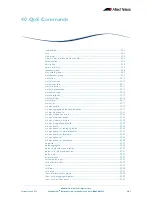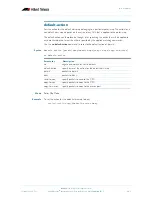
Quality of Service (QoS)
©2008 Allied Telesis Inc. All rights reserved.
Software Version 5.2.1
AlliedWare Plus
TM
Operating System Software Reference C613-50003-00 REV E
39.33
Storm Protection
Storm protection uses QoS mechanisms to classify on traffic likely to cause a packet storm
(broadcast and multicast). The per-port storm protection mechanism simply discards any traffic
over the configured limit. However, with QoS storm protection, several actions are possible
when a storm is detected:
■
You can disable the port physically.
■
You can disable the port logically.
■
You can disable the port for a particular VLAN.
Before you can configure storm protection, you must first enable enhanced mode by using the
platform enhancedmode command on page 15.12
. When a storm is detected on a port, a
message is automatically recorded in the log, and you can configure an SNMP trap to signal that
a port has been disabled. When a storm is detected on a trunk or port group, the entire trunk
or port group is disabled.
The following table explains the basic concepts involved with storm protection.
To set the action to take when triggered by QoS Storm Protection (QSP), use the
storm-
protection command on page 40.66
To set the time to re-enable the port once disabled by QSP, use the
storm-downtime
command on page 40.65
To enable the Policy Based Storm Protection QSP, use the command
storm-protection
command on page 40.66
Concept
Description
Window
The frequency at which traffic is measured to determine whether storm
protection should be activated.
Rate
The amount of traffic per second that must be exceeded before the
switch takes the configured action.
Action
What the switch does when it detects a storm on a port.
Timeout
The length of time the port remains disabled after a port has been
disabled due to a packet storm.
















































